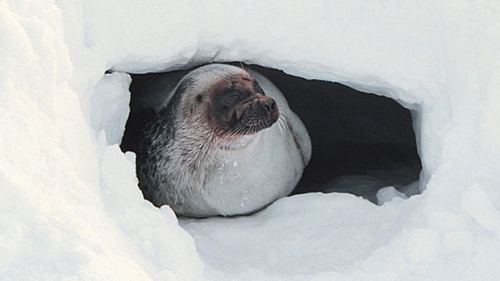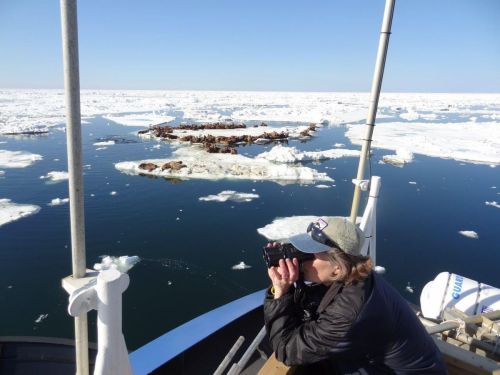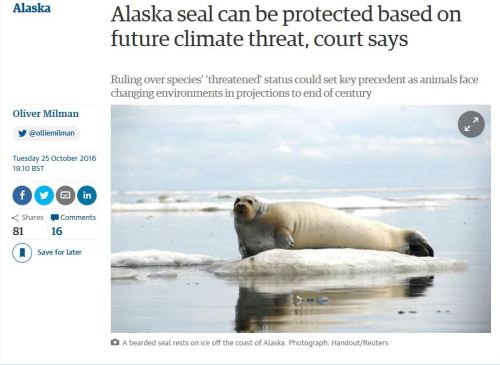This isn't news but it's good to hear it again, this time from the mouth of one of the biologists who collects the data: against all odds, the primary prey species of polar bears are doing spectacularly well.

According to leading seal biologist Lori Quakenbush of Alaska Department of Fish and Game, ringed and bearded seals in the Chukchi Sea are doing great (ADN, 11 February 2019, "Seals seem to be adapting to shrinking sea ice off Alaska"):
"We're seeing fat seals," said Lori Quakenbush, a wildlife biologist with the Alaska Department of Fish and Game's Arctic Marine Mammal Program. "They are reproducing earlier than they have in the past, which says they are getting enough nutrition at this point to grow quickly and become reproductive at an earlier age."
 Ringed and bearded seals across the Arctic, including the Chukchi and Bering Seas, were listed as threatened in 2012 by the US, hot on the heals of polar bears given the same status in 2008 (USFWS 2008, 2012a, 2012b). But American biologists didn't even pretend that the seals were currently suffering, they simply assumed they would sometime in the future (Cameron et al. 2010; Kelly et al. 2010).
Ringed and bearded seals across the Arctic, including the Chukchi and Bering Seas, were listed as threatened in 2012 by the US, hot on the heals of polar bears given the same status in 2008 (USFWS 2008, 2012a, 2012b). But American biologists didn't even pretend that the seals were currently suffering, they simply assumed they would sometime in the future (Cameron et al. 2010; Kelly et al. 2010).
Now, ten years worth of low sea ice of the kind expected to drive polar bears to the brink of extinction later, and ringed and bearded seals are doing better than they did in the late 1970s and early 1980s when there was more summer ice (Adam et al. 2019; Crawford and Quakenbush 2013; Crawford et al. 2015). Quakenbush now has data that extends the period of recent research to 2016, from 2013 previously.
It's hard to imagine stronger evidence in support of retracting the ESA 'threatened' species status designation for ringed and bearded seals: clearly, ringed and bearded seals did not respond as expected when summer sea ice declined dramatically in 2007.
However, all that seems to have happened is that Quakenbush is willing to admit to a journalist that biologists can't tell the future:
"…two predictions that we made about what could be bad for walruses, just within a couple of years turned around and were sort of the opposite."
Quakenbush has been watching marine mammals throughout her long career, and she has given up predicting their future. She says that biologists know what the animals do with ice because they have studied that, but we don't know what they do without it.
Read the whole thing here.
Unfortunately, predicting the future was precisely what US biologists insisted they could do accurately in 2012, even though no other conservation organization in the world concurred with their assessemnt, including the IUCN. The IUCN Red List classified both ringed and bearded seals as species of 'Least Concern' in 2008 and in 2016 (Kovacs 2016; Lowry 2016; Kovaks and Lowry 2008; Kovacs et al. 2008).1

Footnote 1. The suggestion made in this article that Sea of Okhotsk ringed seals have only recently begun to give birth on the sea ice without making snow caves or 'lairs' is not true. Sea of Okhotsk ringed seals have been known to give birth in the pack ice (not on fast ice) without snow dens since at least the 1960s (Fedoseev 1975:158; Kelly et al. 2010a:10) and also in the ice of western Svalbard (Smith et al. 1991:129).
References
Adam, R., Bryan, A., Quakenbush, L., Crawford, J., and Biderman, L.2019. Bearded seal productivity in Alaska using harvest-based monitoring, 1975-2016. Poster presentation, Alaska Marine Science Symposium, 28 January-1 February.
Abstract: Declines in arctic sea ice extent, thickness, and duration are projected to negatively impact bearded seals (Erignathus barbatus) by reducing their time to rest, pup, nurse, and molt on sea ice. Existing population estimates for bearded seals in Alaska cannot be used to detect trends; however, the Alaska Department of Fish and Game works with Alaska Native hunters to collect data from the subsistence harvest that are used to determine several population health indices, such as: pregnancy rate, age of maturity, and the proportion of pups in the sampled harvest. These indices were previously used to determine if declines in sea ice have affected bearded seals between 1975–1984 and 2003–2014.
During these time periods pregnancy rates varied minimally (92–99%); however, the average age of maturity decreased from 4.2 years in 1975–1984 to 2.9 years in 2003–2014. Additionally, pups were harvested in lower proportions during 1975–1984 than during 2003–2014 (26% and 48%, respectively), indicating that pups are still being produced, weaned, and are surviving to be harvested. Through 2014, we have not detected the decreases in population indices that have been predicted to occur with climate change. However, due to continued declines in sea ice, further monitoring is important; therefore, here we update our 1975–2014 results to include samples from 2015 and 2016.
Cameron, M. F., Bengtson, J. L., Boveng, J. K., Jansen, J. K., Kelly, B. P., Dahle, S. P., Logerwell, E. A., Overland, J. E., Sabine, C. L., Waring, G. T. and Wilder, J. M. 2010. Status review of the bearded (Erignatha barbatus). NOAA Technical Memorandum NMFS-AFSC-211.
www.afsc.noaa.gov/Publications/AFSC-TM/NOAA-TM-AFSC-211.pdf
Crawford, J. and Quakenbush, L. 2013. Ringed seals and climate change: early predictions versus recent observations in Alaska. Oral presentation by Justin Crawfort, 28th Lowell Wakefield Fisheries Symposium, March 26-29. Anchorage, AK. Abstract below, find pdf here:http://seagrant.uaf.edu/conferences/2013/wakefield-arctic-ecosystems/program.php

Crawford, J.A., Quakenbush, L.T. and Citta, J.J. 2015. A comparison of ringed and bearded seal diet, condition and productivity between historical (1975–1984) and recent (2003–2012) periods in the Alaskan Bering and Chukchi seas. Progress in Oceanography 136:133-150.
Fedoseev, G. A. 1975. Ecotypes of the ringed seal (Pusa hispida Schreber, 1777) and their reproductive capabilities. In Biology of the Seal, K. Ronald and A.W. Mansfield (eds.), pp. 156-160. Rapports et Proces-verbaux des Reunions, Conseil International Pour L'Exploration de la Mer 169.
Kelly, B. P., Bengtson, J. L., Boveng, P. L., Cameron, M. F., Dahle, S. P., Jansen, J. K., Logerwell, E. A., Overland, J. E., Sabine, C. L., Waring, G. T. and Wilder, J. M. 2010. Status review of the ringed seal (Phoca hispida). NOAA Technical Memorandum NMFS-AFSC-212.
www.afsc.noaa.gov/Publications/AFSC-TM/NOAA-TM-AFSC-212.pdf
Kovacs, K.M. 2016. Erignathus barbatus. The IUCN Red List of Threatened Species 2016: e.T8010A45225428. http://www.iucnredlist.org/details/full/8010/0
Kovacs, K. and Lowry, L. (IUCN SSC Pinniped Specialist Group) 2008. Erignathus barbatus. In: IUCN 2012. IUCN Red List of Threatened Species. Version 2012.2. . Downloaded on 29 December 2012. http://www.iucnredlist.org/details/8010/0
Kovacs, K., Lowry, L. and Härkönen, T. (IUCN SSC Pinniped Specialist Group) 2008. Pusa hispida. In: IUCN 2012. IUCN Red List of Threatened Species. Version 2012.2. . Downloaded on 29 December 2012. http://www.iucnredlist.org/details/41672/0
Lowry, L. 2016. Pusa hispida. The IUCN Red List of Threatened Species 2016: e.T41672A45231341. http://www.iucnredlist.org/details/41672/0
Smith, T. G., Hammill, M. O. and Taugbøl, G. 1991. A review of the development, behavioural and physiological adaptations of the ringed seal, Phoca hispida, to life in the arctic winter. Arctic 44:124-131.
US Fish & Wildlife Service (USFWS). 2008. Determination of threatened status for the polar bear (Ursus maritimus) throughout its range. Federal Register 73: 28212-28303.
US Fish & Wildlife Service (USFWS). 2012a. Threatened status for the Arctic, Okhotsk and Baltic subspecies of the ringed seal. Federal Register 77: 76706–76738.
US Fish & Wildlife Service (USFWS). 2012b. Threatened status for the Beringia and Okhotsk distinct population segments of the Erignathus barbatus nauticus subspecies of the bearded seal. Federal Register 77: 76740–76768.
from Climate Change Skeptic Blogs via hj on Inoreader https://ift.tt/2IAzhd2
No comments:
Post a Comment